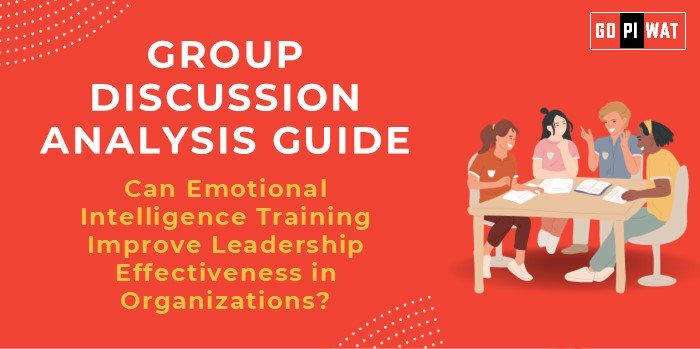📋 Group Discussion Analysis Guide: Can Emotional Intelligence Training Improve Leadership Effectiveness in Organizations?
🌐 Introduction to Emotional Intelligence (EI) and Leadership Effectiveness
- 📜 Opening Context: Emotional intelligence (EI) has become a critical success factor for leadership in modern organizations, enabling leaders to manage teams, relationships, and self-awareness effectively.
- 📖 Topic Background: Introduced by Daniel Goleman in the 1990s, EI refers to the ability to identify, understand, and manage one’s own emotions and those of others. Organizations globally are investing in EI training to enhance leadership effectiveness and organizational culture.
📊 Quick Facts and Key Statistics
💼 $366 billion: The global corporate training market (EI-based programs are gaining traction).
🌟 90%: Top performers in leadership roles have high emotional intelligence (TalentSmart).
📈 70%: Leaders who undergo EI training report improved team performance and engagement (Harvard Business Review, 2023).
🤝 85%: EI is considered a stronger predictor of success than IQ in leadership roles (World Economic Forum).
🌟 90%: Top performers in leadership roles have high emotional intelligence (TalentSmart).
📈 70%: Leaders who undergo EI training report improved team performance and engagement (Harvard Business Review, 2023).
🤝 85%: EI is considered a stronger predictor of success than IQ in leadership roles (World Economic Forum).
🤝 Stakeholders and Their Roles
- 🏢 Leaders: Develop emotional awareness and interpersonal effectiveness to enhance decision-making and collaboration.
- 👩💼 HR Departments: Design and implement EI-based training programs.
- 👥 Employees: Experience improved morale, communication, and team synergy under emotionally intelligent leaders.
- 🌍 Organizations: Gain improved performance, reduced turnover, and better adaptability to change.
- 🎓 Training Providers: Offer tailored programs for EI development.
🏆 Achievements and Challenges
✨ Achievements:
- 🌟 Enhanced Leadership Effectiveness: Leaders with strong EI improve team cohesion and productivity.
- 🤝 Improved Conflict Resolution: EI training equips leaders to manage disputes constructively.
- 📊 Better Decision-Making: Emotional regulation helps leaders think clearly under pressure.
- 📈 Increased Employee Engagement: Leaders’ empathetic communication fosters trust and loyalty.
⚠️ Challenges:
- ❓ Subjectivity of EI Measurement: Difficult to quantify improvements.
- 🚫 Resistance to Training: Leaders may view EI training as non-essential or stigmatize emotional discussions.
- 🌍 Cultural Differences: EI perception varies across global organizations.
🌍 Global Comparisons:
- 🇺🇸 USA: Tech giants like Google and Amazon invest in EI-based leadership training to boost innovation.
- 🇯🇵 Japan: Cultural focus on group harmony aligns naturally with EI principles in leadership.
📚 Case Studies:
- 💡 Google’s Project Oxygen: Showed that effective leaders excelled in people-oriented skills, including empathy and communication.
- 📈 Microsoft’s EI Training: CEO Satya Nadella’s emphasis on empathy transformed company culture and performance.
🗣️ Structured Arguments for Discussion
Supporting Stance: “Emotional intelligence training enhances leaders’ ability to manage teams and adapt to challenges effectively, ultimately improving organizational success.”
Opposing Stance: “EI training is subjective, difficult to measure, and may not significantly impact leadership effectiveness in highly technical roles.”
Balanced Perspective: “While EI training improves leadership communication and adaptability, its success depends on individual willingness and program design.”
💡 Effective Discussion Approaches
- 📜 Opening Approaches:
- 📊 Statistic-Based: “90% of top-performing leaders have high emotional intelligence, highlighting its direct impact on leadership outcomes.”
- 📚 Case Study: “Satya Nadella’s leadership transformation at Microsoft showcases the power of empathy in corporate success.”
- 🛠️ Counter-Argument Handling:
- ⚠️ Challenge: “EI is hard to measure objectively.”
- ✅ Rebuttal: “Case studies from companies like Google demonstrate measurable improvements in team performance and engagement.”
📈 Strategic Analysis of Strengths and Weaknesses
- 🏅 Strengths: Boosts team productivity and morale; improves conflict resolution skills; enhances adaptability and decision-making.
- ⚠️ Weaknesses: Subjective evaluation metrics; requires long-term behavior change.
- 💡 Opportunities: Integrating AI for EI measurement and feedback; expanding EI training for middle management.
- ⚡ Threats: Resistance from traditional leadership structures; cultural variations in EI effectiveness.
🎓 Connecting with B-School Applications
- 📚 Real-World Applications:
- Corporate projects on leadership training frameworks.
- Research on AI-based tools for measuring EI in leaders.
- 💬 Sample Interview Questions:
- “How can emotional intelligence help leaders manage diverse teams?”
- “Can EI training replace traditional leadership development programs?”
- 🔑 Insights for B-School Students:
- Understanding EI prepares students for effective team management during internships.
- EI-related research can enhance consulting and organizational behavior projects.


